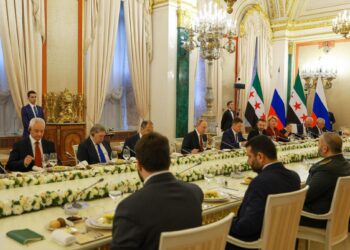Fadel Abdulghany
The national flag pin represents much more than a mere decorative item in the context of government protocol and diplomatic relations. According to contemporary diplomatic literature, these small symbols are one of the most important manifestations of national identity and tools of protocol in modern state interactions. Wearing a flag pin is a symbolic act that embodies meanings of patriotism, unity, and respect for sovereignty. Within the complex structure of diplomatic protocol, the flag pin has evolved into what can be described as a “symbol” that embodies the nation, its history, and its aspirations. This symbolic load gains particular importance in bilateral meetings, where the careful display of national symbols sends thoughtful messages about the nature of relations between states, while maintaining a delicate balance between mutual respect and affirmation of sovereign identity.
The transition of flag badges from an optional accessory to an integral component of government protocol reflects a broader shift in the state’s representation of national symbolism. The historical trajectory of this practice highlights how political norms crystallize into binding diplomatic requirements. Citizens’ expectations of officials to demonstrate national loyalty through visible symbols have increased, particularly following pivotal national events involving threats to security or unity, or in countries emerging from armed conflict, such as Syria. This has elevated the flag badge from a personal choice to a necessity for national unity.
In this context, the description of the flag pin as a “national symbol” goes beyond the confines of a ceremonial display to represent the sovereign weight of the state, given that the flag is the pinnacle of expression of national identity and state authority, a status that inherently extends to its miniature image on the lapel. Modern protocol practices affirm the primacy of the flag over all other emblems and symbols, a principle that equally applies to flag pins on official occasions. This primacy is not arbitrary, but rather reflects the flag’s status as the supreme symbol of the state in the international system.
In addition, the institutionalization of the use of badges embodies an intersection between symbolic communication and political messaging. These symbols are effective communication tools capable of conveying complex messages about national identity, political consensus, and diplomatic relations. Their impact on public perception demonstrates that they reinforce political positions and help leaders identify with key social segments. Thus, the badge serves a dual function, both internally and externally: consolidating national unity at home and representing the state and its values abroad, thus consolidating its position as an indispensable element in public affairs management and state-building.
Diplomatic Protocol and International Standards for the Use of Flag Badges
The inclusion of flag badges in diplomatic protocol is governed by precise rules of etiquette that embody respect for national sovereignty and regulate interactions between states. In the context of international meetings, the placement and display of badges is subject to established standards that reflect broader principles of diplomatic practice. Wearing the badge on the left lapel, near the heart, is a symbolic gesture of national loyalty, while adhering to international norms for displaying national symbols.
In bilateral meeting protocols, the principle of equal prominence prevails in the display of national symbols, including the personal badges worn by officials. This principle embodies mutual respect between states, clearly demonstrating each representative’s loyalty to their nation. This practice facilitates immediate visual recognition of national representatives, enhancing diplomatic efficiency and clarity. The “crossed flag” badges, presented as protocol gifts, demonstrate how symbolism has evolved from representing a single state to evoking bilateral friendship and cooperation.\ The codification of insignia protocols by an increasing number of states has contributed to the formation of a quasi-uniform system of diplomatic expression that is widely applicable. Government missions, agencies, and international organizations have incorporated flag insignia into their approved dress codes, demonstrating their contemporary importance in diplomatic practice. This entrenchment has reached such an extent that the absence of the insignia has become more conspicuous than its presence, reflecting the extent to which it is integrated into the requirements of daily diplomatic work.
The codification of insignia protocols by an increasing number of states has contributed to the formation of a quasi-uniform system of diplomatic expression that is widely applicable. Government missions, agencies, and international organizations have incorporated flag insignia into their approved dress codes, demonstrating their contemporary importance in diplomatic practice. This entrenchment has reached such an extent that the absence of the insignia has become more conspicuous than its presence, reflecting the extent to which it is integrated into the requirements of daily diplomatic work.
Conclusion
Flag emblems have undergone a remarkable transformation from a mere expression of national sentiment to a central element of government and diplomatic protocol. This transformation reflects the expanding ways in which states express identity, sovereignty, and mutual respect in a highly interconnected world. The description of flag emblems as the “supreme national symbol,” preceding all other emblems, underscores their importance in representing national identity, particularly in countries emerging from armed conflict. They also represent state authority, particularly in bilateral meetings, where the disciplined display of symbols conveys essential messages about the nature of relations, while preserving the dignity and sovereignty of states.
The theoretical framework governing the protocol of insignia demonstrates that seemingly minor details carry profound symbolic weight. The convergence of historical traditions, international law, and diplomatic norms has led to the formation of a global system of symbolic communication that transcends cultural and political boundaries. Insignia represent a visual expression of national loyalty that transcends language barriers, facilitating diplomatic engagement and strengthening national identity. While officials at all levels continue to adopt these symbols in their professional presence, flag insignia remain a fixture of modern statecraft and a testament to the effectiveness of symbolic communication in international relations.






